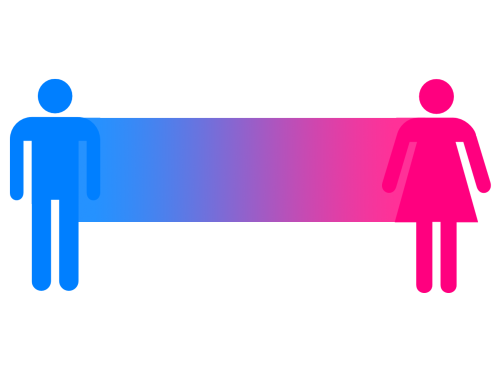Gender. It’s complicated. It’s simple. It means a bunch of different things to a bunch of different people in a bunch of different contexts. What is it?
English isn’t very well-equipped to talk about gender-related topics yet. The terms are still emerging and shifting. “Gender” can refer to cultural roles, bodies, personalities, appearances, and stereotypes, among other things. Yet, we use one word to refer to all of this as if these things are the same. We know that they are not the same, and we know that the false equivalencies drive some of the cultural problems that lead to hate and violence against some people.
To separate out these concepts, academics use various terms such as “gender identity,” “gender role,” “gender presentation,” “sex assigned at birth,” and so on. Each of these terms has variations, many of which also vary in nuance. One term that has unfortunately gained popular traction leading to a wide public misunderstanding of gender is “the gender spectrum.”
We know that biological sex is not binary. Sex is currently defined by multiple things such as gonads, chromosomes, and hormonal balance. Each of these variables operates somewhat independently, and each one has far more than two options, which results in a plethora of human sexes, not just two.
We also know that someone’s gender identity is not determined by genital sex, so it makes sense that the M and F slapped on people’s birth certificates often has nothing to do with people’s gender identities.
So if there are more than two sexes, and there are more than two genders, why is it a problem to call it a spectrum?
A spectrum is variation along a single axis. Take the electromagnetic spectrum, for example. It ranges from the shortest wavelength radiation can have to the longest wavelength, with a narrow range of light that is visible to the human eye somewhere in the middle. This spectrum is pictured below, with the visible light repeated at the bottom, zoomed in for ease of seeing all of it:

If we apply the concept of a spectrum to gender, the idea in people’s heads is often a straight line gradient that exists between the only two reference points offered by mainstream white western culture: man and woman. The area in between is labeled as “nonbinary” and people move on about their lives erroneously believing they have a working understanding of gender and all of its possibilities. That spectrum might look something like this:

Gender does not work like this. Gender is not just a gradient between man and woman. To be fair, there are a lot of people who do exist on that line. It’s just not a complete picture.
There are also people who exist off of that line. Some of these people who exist off of that line are still related to that line (such as people who are demiboy or demigirl, among others), but others are entirely separate (such as people who are egogender, agender, juxera, and more). In fact, people who aren’t on that line at all but still have a strong sense of gender are common enough that there is a word for it: aporagender.
Treating the “gender spectrum” as “this is what the full extent of gender is” isn’t accurate and leads to erasure of and discrimination against people who don’t fit in that model. It is better than claiming that men and women are the only two possible genders like so much of mainstream Western culture tries so hard to do, but it is still not accurate. There are still a lot of aporagender people who aren’t represented by this model.
“Nonbinary,” (or “non-binary”) in terms of gender, does not mean “somewhere between man and woman or a mix of the two.” It means “anything other than 100% man or 100% woman,” as “binary” refers specifically to people who are completely men or completely women. Due to the wildly diverse nature of gender, this cannot be summarized by a single axis. (While we’re at it, it’s worth mentioning that the abbreviation NB already means “non-black” in social jargon so “nonbinary” is abbreviated as “enby” instead.)
So, what’s a better blanket term than “the gender spectrum?”
Language is constantly evolving, and English has only just begun to incorporate the reality of the existence of more than two genders. We may not settle on the right term for quite some time. For now, “gender cloud” is a much more thorough model than “gender spectrum.”
A cloud is an amoebous form. The vague nature of this allows it to become what we need it to be, rather than restricting the way we think about gender to a single axis and thereby ignoring large parts of what it is and how it works. Here is an example drawn by Tumblr user bahamutzero:

If we continue to say “gender spectrum,” the first (erroneous) model is what will come to mind to most people. It’s not a useful communication tool, and in fact, does harm by promoting the erasure of and discrimination against aporagender people.
So true. Your article has acted like a touch and highlighted the problem with putting “Gender” and spectrum together. ( Like using the term Autism Spectrum, puts all the focus on Autism.) “Gender cloud” is a great term.
LikeLiked by 1 person